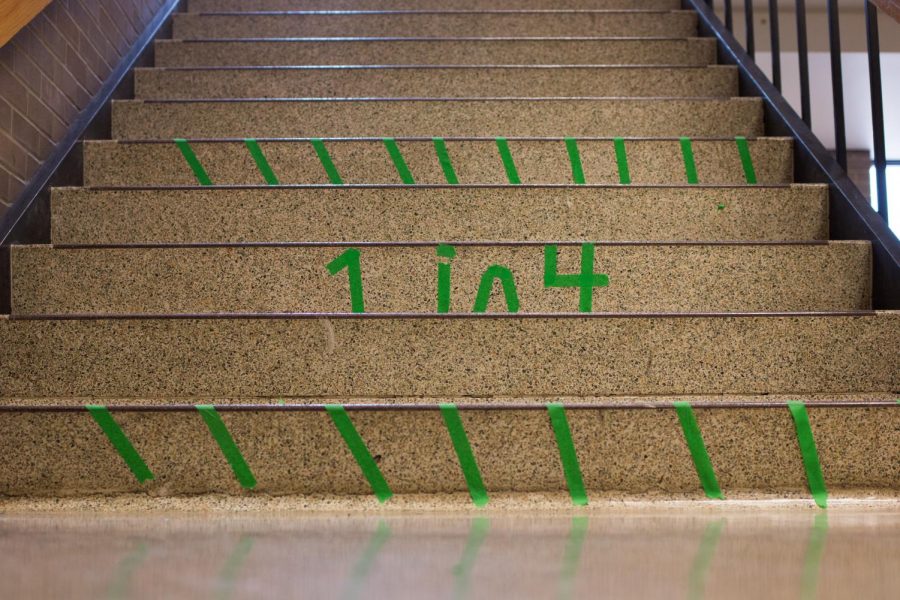1 in 4 of Us
Mental illnesses are more common than you may think
Every green stair that SADD displayed showed a person fighting, but it also showed a person we can help, in a way big or small.
February 6, 2019
A couple of weeks ago, I noticed something had changed about our school — some of the stairs were covered in green tape. I counted, one, two, three, four and saw the big green sign watching over me, proclaiming boldy, bravely, “1 in 4!” I remember mulling that statistic over in my head; 1 in 4 people deal with mental illness or substance abuse problems. 1 in 4 students at our school deal with mental illness or substance abuse problems. And, no matter how hard I’ve tried to hide it from everyone, I’m a part of that quarter.
I first noticed that something was off in the fifth grade. My successive middle school years were a stereotypical nightmare, and I found myself struggling considerably. I was no longer the high-energy, Hermione I had been back at Bradford Woods; I had quieted and roughened, wracked by self-doubt and guilt at too many things. I became — to put it bluntly — super gross. Depression isn’t the pretty, tragically feminine garbage the TV taught me; it’s no makeup (queue: are you sick?), it’s leggings (even when the thighs rip), and it’s upwards of thirty pounds. From middle school through my years at NAI, I hated how disgusting I’d become. So, I enacted some rules for myself when I entered NASH.
My little constitution made me into a new woman. My two-leggings-a-week rule forced me into dresses, and the five-different-shoes-a-month one got me into heels and loafers. Makeup on, hair clean, checklists, and books kept anyone from worrying. I learned that if I pulled out a compact, people trusted me. If I wore tights, I was fine. I got my work done and saved the tears for my pillow. I was put-together. I was hidden.
Now, though, I’ve begun to see my fallacies. When I was sixteen, I was diagnosed with depression and told my illness had likely begun at the age of eleven. I’m eighteen now; seven years of my life have been consumed by mood swings and weight gain and guilt. What I mourn the most, though, is not the lost time from my depression. It’s instead the lost time from my isolation.
I pushed people away. I scared my mother and my teachers, and I was too selfish to notice anyone’s pain but my own. I failed to see the hurt of others — related or unrelated — because I was so wrapped up in a twisted pride for my stupid rules that I ceased to be the empathetic woman that I both wanted desperately and shunned pathetically. I thought I had a monopoly on middle school pain. Friends around me struggled as well, with parental divorce, mental health, physical ailments — things I understood tragically well — but I hung them out to dry. I prided myself on my privacy, but in doing so, I severed a valuable source of empathy from the people I loved who needed it most.
I know that seven years of the same disorder means that even when I’ve healed, it will still impact me as a person. Maybe (and hopefully) one day, I’ll get to stop sleeping the day away and crying at the word “no,” but the strength and perseverance that I’ve shown through my battle will stay. When I hide my illness, I hide myself, the beautiful and helpful parts included. I was lonely and empty and scared, which only made things worse — but hey, at least I had lipstick on.
So what changed? As much as I was inspired by what SADD had done to the stairs, it was something else entirely. After an especially awful class period of mumbling and blank stares, a teacher handed me a note as I walked out of class. All it said was, “Hey, hope all is well.” I ran to the bathroom and cried my eyes out — red eyes, puffy face, and mascara everywhere. It was wake up call in the form of a not particularly profound notecard, and it made me realize something. People noticed, and people cared. And while it wasn’t my duty to let them know what was going on in my life, it was a courtesy and a kindness that I could give.
While I’m undoubtedly still too uncomfortable to directly thank those who have checked in with me over the many years, I am grateful. Take this as my thanks. To ask someone if they’re okay and genuinely want to hear the response is tantamount to the question itself, and I have found the courage to write this because of you.
I regret my self-consuming years, in which I was too absorbed with my own pain to see how I could help others. But to be checked in with reminded me that I am not an island, and I learned that if a simple note from someone else can affect me so, it can also benefit others.
I understand that I can’t speak to every person in the building, but I can post this and hope it does a little of what my message did for me. So please, check in with a friend. If they’re on your mind, send them something — they don’t need a dramatic essay, just a friendly reminder that you’re there. A text, some advice, a list of resources. Anything that lets a person know that they are not alone — that people care about them and that they have the ability to help others as well.
If the SADD tape display taught me anything, it’s that mental illness and substance abuse issues are much more common than I ever knew. Every green stair showed a person fighting, but to me, every green stair showed a person I could help, in a way big or small. So please, extend that. And maybe, we’ll all feel a little less alone.













Mr. Longo • Feb 8, 2019 at 11:58 am
Great job, Alex! Thank you for writing this article.
Katelyn Steigerwald • Feb 7, 2019 at 7:55 am
Alex, this is an extremely powerful article. Thank you for sharing your story with others!